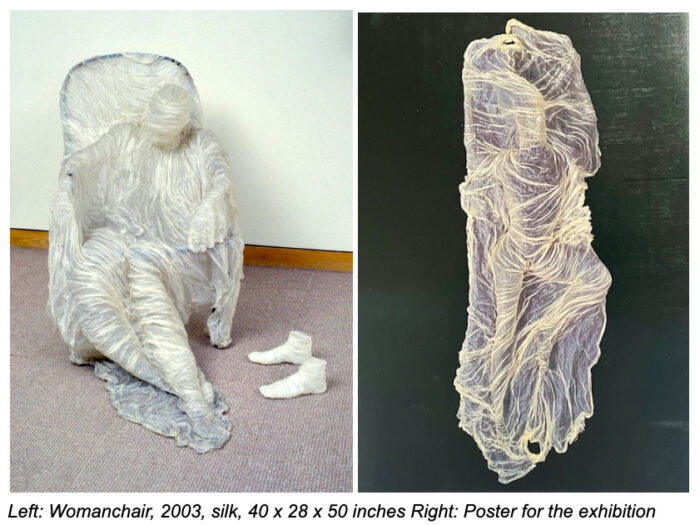Helga von Eicken Kopperl (1936-2024) was born in Montreal, Canada, and received her BFA from Carnegie-Mellon University, Pittsburgh, Pennsylvania. Helga moved to New York in the 1970s and exhibited as a performance poet, printmaker, and sculptor. She is in the collection of The Museum of Modern Art, New York; a collagraph from 1996.
On this occasion, we revisit her exhibition in the Narthex and Stairwell Gallery at Saint Peter’s Church on 619 Lexington Avenue New York, NY 10022. Her show, Presence of Absence, is a sculpture installation of white silk figures and works on paper. The exhibition ran from May 3, 2003, until August 24, 2003.
 More than 50 years ago, Elaine de Kooning began curating a gallery in the parish hall of the “old” Saint Peter’s Church in New York City. That tradition continues to this day. Helga’s exhibition was part of the visual arts program at Saint Peter’s Church, which was dedicated to the exhibition of art to enhance the human spirit.
More than 50 years ago, Elaine de Kooning began curating a gallery in the parish hall of the “old” Saint Peter’s Church in New York City. That tradition continues to this day. Helga’s exhibition was part of the visual arts program at Saint Peter’s Church, which was dedicated to the exhibition of art to enhance the human spirit.
According to the press release, the Presence of Absence “describes figures no longer present in their original form. Wet silk creates a body cocoon … and when the stiffened shell is completed, a sense of the absent body remains.” In her own words, Helga is quoted as saying “I experience these figures not as portraits with personality, but as essences. There is something akin to spiritual exercise in their making. To my eyes, they appear frozen as if some force has stopped them. Light passing through white gives a semblance of purity.”
Light passing through the silk affirms that the essence of something is its pure form, not the material or physical. The works are undoubtedly figural but have no specific defining figures, except to say that they are very human. We can understand the human aspect of the work as a belief that physical form precedes the spiritual realm.
Absence is often conceptualized as a void; this void has been assigned a color (think the black void of space.) Helga’s treatment of translucent white silk stands up to the metaphor that the void is represented by darkness. While the show’s title recognizes a sense of loss and memory, it is Helga’s perspective, which calls us forward, into the realm of the spiritual. Helga takes the idea of hollow form to represent a transcendence. Although Helga was not overtly religious, her statement about the work leaves room for us to make a mystical interpretation.
In the Buddhist tradition, as found in The Tibetan Book of the Dead, one passes through death and into the intermediate state of reality. In this belief system, after respiration has stopped, the deceased may experience phenomena of sounds, light, and rays of light. One of the lights that becomes manifest is that of the brilliant white light. This bright white light is indicative of pristine cognition. In the transition state after death, the deceased is meant to concentrate on the bright white light and recognize it as pure cognition. The goal of any Buddhist is enlightenment and transcendence from suffering. If enlightenment is not achieved in life, it can be found after death. In the intermediate state of reality, one can recognize the the bright white light as a pathway of liberation from the cycles of suffering, and into the level of an utterly perfect Buddha. We can realize these sculptures as essences that followed the bright white light away from the hell realms, and into Buddhahood.

Loved the article by Max Heaton . A beautiful tribute to a wonderful lady .